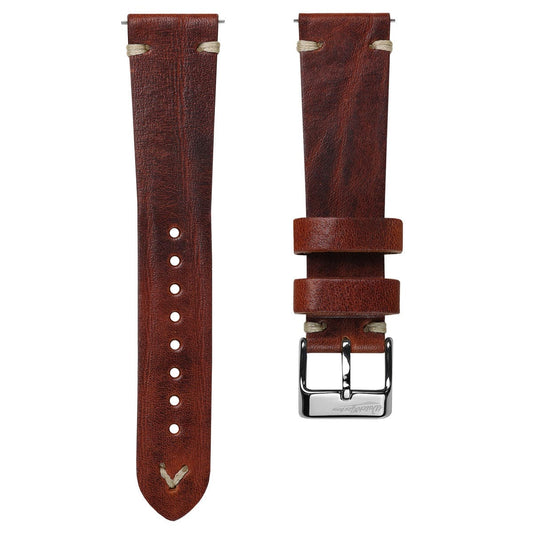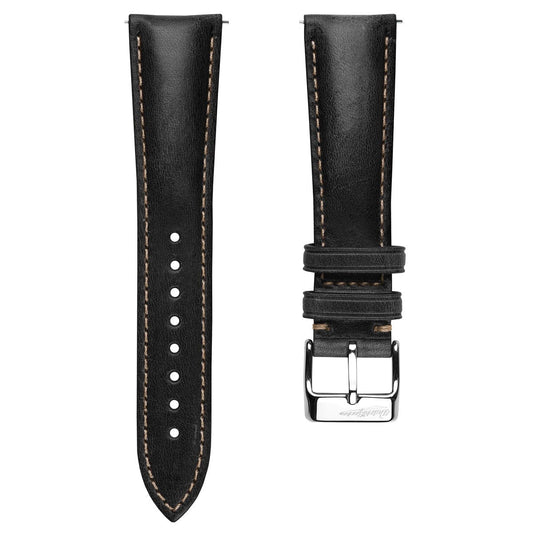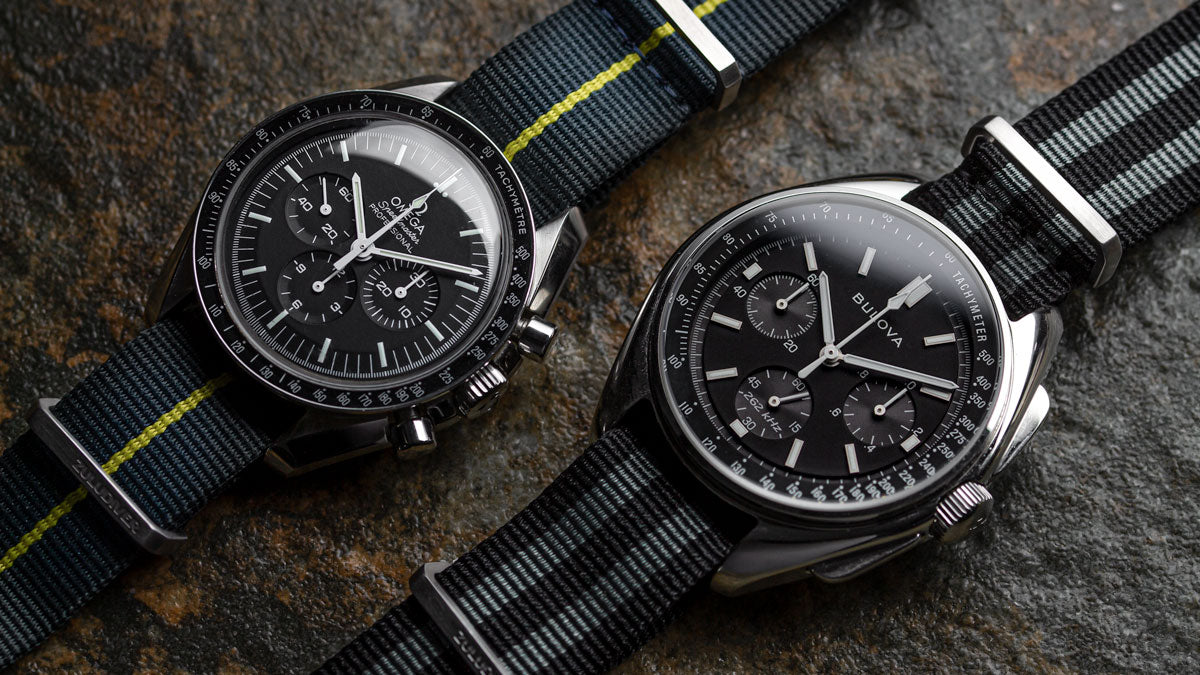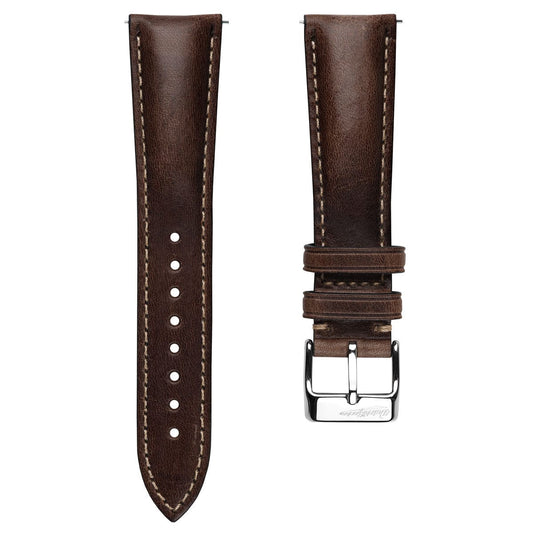A battle of the moon watches, but who is the winner?
Only two watches are confirmed to have been worn on the moon. The mechanical Omega Speedmaster (reference 105.012 and the 1966 update 145.012) and an automatic prototype Bulova (reference 88510/01). Other watches have certainly flown in space and are unofficially believed to have been worn as back-up watches, such as Ed Mitchell’s Rolex on Apollo 14, but there is no conclusive evidence such as NASA images or film.

The Omega Speedmaster on the Simple Handmade Leather - Image Credit: WatchGecko Online Magazine
- Regular price
- $140.00 AUD
- Regular price
-
- Sale price
- $140.00 AUD
- Unit price
- per

- Regular price
- $140.00 AUD
- Regular price
-
- Sale price
- $140.00 AUD
- Unit price
- per

 By NASA / James McDivitt (Great Images in NASA Description) [Public domain], via Wikimedia Commons
By NASA / James McDivitt (Great Images in NASA Description) [Public domain], via Wikimedia Commons
Apollo 15 mission Commander Dave Scott’s actual Bulova chronograph which he wore on EVA3 on the moon on 02 August 1971 was a personal watch, tested as a favour to a friend, and was sold by Scott himself in 2016 for £1.25 million. The watch was presented on his original NASA Velcro strap made for the Omega which still had moon dust stuck in the fibres.
Returning to “the good Earth”...

The Omega Speedmaster vs The Bulova Lunar Pilot Chronograph - Image Credit: WatchGecko Online Magazine
For those of us desiring to own a watch of Apollo significance, but not having the budget to remotely consider a genuine NASA artefact, what are the options? The good news is there are three. First is a relatively new or pre-owned modern Omega Speedmaster. This will still be very faithful to the 1960s models which accompanied astronauts walking across the Oceanus Procellarum. The second and third option is one of two Bulova Apollo 15 Lunar Pilot Chronograph commemorative watches which have been released.
These are superficially good copies of the original moon watch but come with a significant technical difference. If we are to have a meaningful comparison of the three watches it makes sense to divide our study into several criteria; appearance, function and movement, value for money and, most important, how does it feel for those of us seeking an authentic experience? When you look at it, does it transport you to the Command Module of Apollo 8 orbiting the dark side of the moon?
The Omega Speedmaster Professional Moonwatch
There are a number of Omega Speedmaster models available today, including highly sophisticated new models which boast the Master Chronometer label, but there is only one truly authentic Moonwatch as selected by NASA. This can currently be purchased under Omega reference 311.30.42.30.01.005. The watch is 42mm in diameter with a steel case and back, hesalite crystal lens and a hand-wound calibre 1861 movement.
The Omega Speedmaster - Image Credit: WatchGecko Online Magazine
By taking this model as our benchmark for the study we remain as close as possible to the Apollo issue watches, none of which had any additional design features such as crystal case backs, moon-phase dials, date windows or precious metals. Of course, these newer complications serve to make the Speedmaster range one of the most stunning watch portfolios available but this exercise is about moon watches and we should remain as historically accurate as possible.

The Omega Speedmaster on the Highley Leather- Image Credit: WatchGecko Online Magazine
- Regular price
- $140.00 AUD
- Regular price
-
- Sale price
- $140.00 AUD
- Unit price
- per

- Regular price
- $140.00 AUD
- Regular price
-
- Sale price
- $140.00 AUD
- Unit price
- per

- Regular price
- $140.00 AUD
- Regular price
-
- Sale price
- $140.00 AUD
- Unit price
- per

Visually the Speedmaster Moonwatch is a stunning timepiece. It was striking when it first flew in space in 1962 with Wally Schirra in SIGMA 7 and it has somehow managed to transcend age, becoming timeless; a beautiful watch which today still orbits the Earth, used by astronauts in the ISS. It is arguably one of the most iconic watches of all time because of its historic use and the romanticism it generates for those of us who still dream of the Gemini and Apollo missions. Combine these powerful factors with clever Omega marketing which captures the magic of Apollo and the watch is as a sure winner.

The Omega Speedmaster - Image Credit: WatchGecko Online Magazine
The Speedmaster Professional is supremely legible and functional yet presents an elegance not often seen in such timepieces. The long slender hands give the night-black face a wide-open feel and the uncluttered dial makes time reading effortless. The sweep chronograph hand with its arrowhead and extra-long needle ensures accuracy while the sunken sub-dials, like moon craters, give the watch face three dimensions and subtle depth. The luminescent indices are not over large yet at night they glow with a bright green intensity. The stainless steel case is robust but not overly bulky, especially when you look directly at the watch. The case back is decorated with the famous Omega mythological Hippocampus and bears quite possibly the most impressive engraving on any watch back. “Flight qualified by NASA for all manned space missions. The first watch worn on the Moon”.

‘The First Watch Worn On The Moon’ - Image Credit: WatchGecko Online Magazine
The lens is made from hesalite crystal. An easily scratched plexiglass but without which the Speedmaster would not be the original Moonwatch. NASA developed hesalite to not shatter if impacted. It will crack across its width but due to the unique construction of the material, no particles will break free and escape.

The Omega Speedmaster - Image Credit: WatchGecko Online Magazine
In the heart of the current Speedmaster Moonwatch beats the very capable, hand-wound, 48-hour calibre 1861 movement. In 1968, Omega replaced the original calibre 321 in favour of the 861 which replaced column-wheel switching with a cam and generated an increased pulse of 21,600 VPH. Today’s Speedmaster Professional uses a rhodium-plated version of the 861 (the 1861) and also comes with an anti-magnetic dust cover and the ubiquitous, easy to use, tachymeter scale on the outer bezel. Purely from a technical user perspective the Speedmaster perhaps feels a little unsophisticated in its operation. The functionality is perfectly adequate and accurate but the sweep second hand of the chronometer is not particularly smooth when compared to a similar era Breitling Calibre 13 (Valjoux 7750 base).
The start/stop and reset push-buttons of the Omega also have a “mushy” quality to them when compared to the Breitling. Does this detract from the watch – not really but it is fair to say that there are better chronograph movements available which feel more solid and reliable to the user.

The Omega Speedmaster - Image Credit: WatchGecko Online Magazine
Perhaps this is a characteristic of Omega feeling an obligation to mirror the current 1861 faithfully to the original 1960s movement and this has prevented evolution?
The Omega is not a cheap watch. The base-level current classic Moonwatch on a steel strap with the steel case back is £4,000 although you can find a good pre-owned model for under £3,000. But bear in mind that this is for a watch which is not waterproof so you will need something else to wear if you intend to deploy a watch in humidity, heat or water. In fairness, waterproofing was really not an issue for the crew of Apollo 11 as the selected NASA watch only had to repel dust and be 100% accurate, but for earthbound wearers, the claimed 50m water resistance is probably not sufficient guarantee to risk dipping your Speedy in a swimming pool.

The Omega Speedmaster on the Beaufort Racing leather strap - Image Credit: WatchGecko Online Magazine
But there is an alternative piece of NASA hardware available which begs our consideration…
The Bulova Lunar Pilot Chronograph

The Bulova Lunar Pilot Chronograph on the Vintage Highley Leather - Image Credit: WatchGecko Online Magazine
The Apollo 15 crew completed three EVA moonwalks. On EVA2 Commander Dave Scott noticed that his Omega Speedmaster was missing its Hesalite crystal lens – effectively ruining the watch. There is no specific data as to why it failed but it is most likely that he knocked it against the lunar rover or possibly even an extreme temperature change popped the lens off (the Moon’s temperature varies between +127C to -173C). Fortunately, Scott carried a backup watch which was a fascinating and unique Bulova chronograph.
Bulova already had a significant relationship with NASA. Every chronometer in the Apollo capsules was made by Bulova using their propriety Accutron mechanism which operated with a triple-pronged crystal fork vibrating at a much higher frequency than a normal quartz clock, thus giving unparalleled accuracy.

The Original Bulova Moonwatch - Image credit RR Auction
However, Bulova was keen to actually get a watch on the Moon and developed a non-commercial unique model for Dave Scott as his backup watch. On the failure of the Omega, Scott deployed the Bulova on EVA3. The watch performed perfectly, and there is clear photographic proof of it both on the surface of the Moon and after splashdown. The Bulova was given to Scott and disappeared from world view, soon to become a space legend.
When the watch was sold in 2016 we really had our first good look at it. A simply beautiful design less cluttered than the Speedmaster, with larger push buttons for easy use with bulky space gloves. The ultra-rare watch immediately became the most desirable NASA/Apollo artefact worldwide, beyond the reach of most, however, thankfully Bulova released a near-perfect copy of it for sale in 2017.

The Omega Speedmaster vs The Bulova Lunar Pilot Chronograph - Image Credit: WatchGecko Online Magazine
The new Bulova Lunar Pilot Chronograph Moonwatch is an impressive piece which faithfully replicates the design of the original Apollo 15 watch. Very reasonably priced at around £500.00 or £400.00 depending on issue model, the more expensive watch comes in a tasteful presentation box with two straps, one blue leather and one long Velcro NASA style. The cheaper model comes in a smaller box with just one NATO style strap. The larger package also has a smart brochure telling the history of the watch and a strap changing tool. The case back of both Bulovas are smartly engraved with Apollo 15 landing dates and Moon coordinates making it from a collector’s perspective every bit as desirable as the Omega.

The Bulova Lunar Pilot Chronograph - Image Credit: WatchGecko Online Magazine
The face is large and legible and definitely less cluttered than the Speedmaster. Sub-dials are slightly sunken and the Bulova has a striking deep channel around the dial which lifts it and almost seems to mirror the Hadley Rille gorge next to Apollo 15s landing spot. Luminescence is not as profound as Omega but glows well enough in a subtle blue through the night. The push buttons on both models are large, giving them a distinctly 1970s look and they are topped off with a substantial chunk of sapphire crystal and the ever-present tachymeter for rocket burn calculations.

The Bulova Lunar Pilot Chronograph - Image Credit: WatchGecko Online Magazine
The Bulova is a large watch at 45mm and is heavy. It also stands very proud from the wrist so if you want a watch with presence and to make a statement then it does this certainly more so than the Speedmaster. The principal differences between the two models we are considering is the case finish. The more expensive watch is a matt bead blasted silver and the dial has a date window, while the cheaper model is polished steel with no date. There is also a font difference on the two dials.
The matt finish watch uses Bulovas current font while the polished model used a blockier font which actually more closely replicates the wording on the original 1971 moon watch. In the perfect world we would combine the two and have a true copy of Scott’s watch which was bead blasted, with no date window and the older font! However, Bulova have made it tough – you have to make a decision between the two. For the sake of completeness, it is also worth noting that Bulova make a matt black PVD coated model of the Moonwatch. It looks good, but nothing like the Apollo 15 original so it is not considered here.

The Bulova Lunar Pilot Chronograph - Image Credit: WatchGecko Online Magazine
Analysing beyond the 50m water resistant exterior, possibly the most interesting element of both watches is that Bulova have made a brilliant decision to equip them with an ultra-modern 262kHz Precisionist high performance quartz movement which derives its operation from the original NASA capsule Accutron chronometers. Bulova guarantee an accuracy of +/- 10 seconds a year with this movement which out performs Breitling’s Superquartz by 5 seconds. The upshot is that you can wear a watch which looks the same as Dave Scott’s Apollo 15 original but with a movement that replicates the clocks in the Apollo capsule; quite possibly a NASA fan’s perfect storm.
Nylon straps for the moon watches

The Bulova Lunar Pilot Chronograph and Omega Speedmaster on Swiss Style NATOs - Image Credit: WatchGecko Online Magazine
One thing both the Omega and the Bulova have in common is that their lug width is 20mm and they both look excellent on aftermarket straps. Given their origins and the whole rationale behind this feature it will come as no surprise that both watches look amazing on a simple black or grey NATO strap which immediately makes them look like NASA issue watches. The NASA strap was Velcro but both these watches look at the top of their game when twinned with the ZULUDIVER Swiss Style Premium NATO Strap. These watches have the bulk to carry the larger buckle and keepers. The Bulova especially looks good when twinned with the strap which has the brushes steel hardware as it is almost identical in colour to the watch case.
Leather straps for the moon watches

The Omega Speedmaster on the Highley Leather - Image Credit: WatchGecko Online Magazine
- Regular price
- $140.00 AUD
- Regular price
-
- Sale price
- $140.00 AUD
- Unit price
- per

- Regular price
- $140.00 AUD
- Regular price
-
- Sale price
- $140.00 AUD
- Unit price
- per

- Regular price
- $140.00 AUD
- Regular price
-
- Sale price
- $140.00 AUD
- Unit price
- per

Almost all Speedmaster models are available with a leather strap option. Therefore it is easy to look at images online and see how your Speedy would appear whether on black or brown leather. In fact, a special 1962 Wally Schirra edition of the Moonwatch is available on brown leather only. As the dial is black the Omega really lends itself to plain leather of the same colour, perhaps accented with some stitching. Geckota’s Vintage Highley Genuine Leather Quick Release Watch Strap (Shorter Length) would seem to be the ideal choice for the watch as its style can carry any of the four available colours well.
The Bulova’s case is bulkier and the 20mm lug width is arguably too small so leather straps, unless dark, do not sit particularly well on it. Lighter coloured straps seem a little lost when fitted to the large steel case. Also be aware of tapering leather straps as they too look disproportionately thin on the watch. A chunky dark leather like the product name works well.
Rubber Straps on the Moon watches

The Omega Speedmaster on the Sailcloth Rubber Strap - Image Credit: WatchGecko Online Magazine
This element works well with both watches and not only gives them a functional NASA look but also a sports feel. As established earlier you are unlikely to take either into the ocean so there are no diving considerations here, but all three watches wear well on rubber and the satin sheen of a quality strap, such as the ZULUDIVER Vintage Tropical Style Rubber or the ZULUDIVER Quick Release Sailcloth greatly complement all the moon watches and give them a rugged look.
There is still one unanswered question. Which watch to buy…?

The Omega Speedmaster vs The Bulova Lunar Pilot Chronograph - Image Credit: WatchGecko Online Magazine
If cost is a factor then the Bulova is immediately the watch of choice. For a relatively low cost, you can buy a high-end watch which feels and looks much more expensive than it is. If technical prowess is your principle buying factor then both brands present a strong case. Find an image online of Omega’s 1861 movement and it is a thing of wonder – a complex mass of moving parts which rivals the thousands of elements in a Saturn V rocket. Equally the Bulova is a quartz masterpiece with one of the most accurate watch movements available – testimony to the precision of space travel.
From an Apollo heritage perspective, especially with the recent 50th Anniversary of the first moon landing, the Omega possibly has the edge. To all intents and purposes, the Speedmaster Professional available today is the same as the one worn by Neil Armstrong and that certainly makes the watch more than worthy of consideration.
However, in the final Battle of the Moon watches there is no clear winner as all three models assessed bring something special to the genre. The choice probably narrows down to a “what if” question...

The Bulova Lunar Pilot Chronograph on the Classic Bond Swiss Style NATO - Image Credit: WatchGecko Online Magazine
- Regular price
- $140.00 AUD
- Regular price
-
- Sale price
- $140.00 AUD
- Unit price
- per

- Regular price
- $140.00 AUD
- Regular price
-
- Sale price
- $140.00 AUD
- Unit price
- per

Latest News
More articles from Richard Brown
- Choosing a selection results in a full page refresh.








